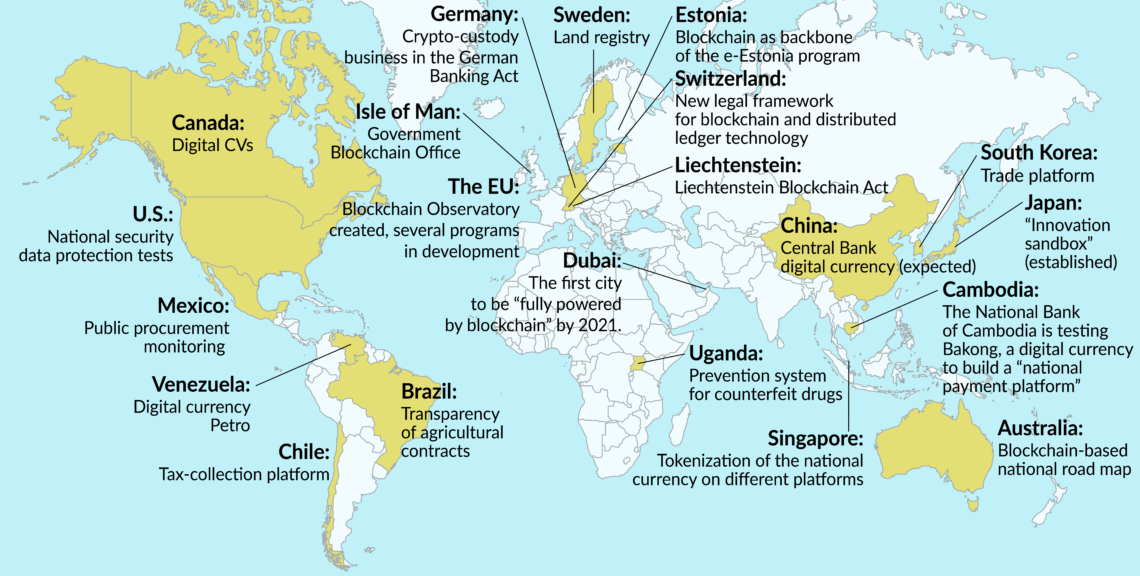Public administration on a journey to decentralization
Blockchain has the potential to revolutionize public administration by fostering efficiency, transparency and automation. There are limits to the technology, but currently the main roadblocks are legal and organizational.

In a nutshell
- The use of blockchain in public administration promises significant advantages
- Regulatory and organizational hurdles need to be removed to allow broader use of the technology
- Public-and-private-sector partnerships are exploring ways to make administrative functions more efficient and transparent
The revolutionary blockchain technology is no longer associated exclusively with financial transactions and the private sector. Governments have started to experiment with the technology in public administration, though with varying levels of success. This report seeks to demonstrate that while such ventures cannot always be successful, a solid basis for the expansion of blockchain in the administrative realm already exists.
Admittedly, it was not love at first sight between blockchain and any administration, as the two function in very different ways. However, there are more synergies between them than meets the eye. Processes that require trust and, therefore, trust mechanisms, are crucial in public administration. Blockchain delivers just that – efficient and decentralized confidence-building in complex processes, from financial issues to worldwide logistics concepts.
The first pilot applications prove these processes are scalable to an institutional level. The technology’s potential is now being examined and applied in pioneer countries’ public sectors – for example, for process automation.
Status quo and perspective
While the use of blockchain technology in public administration is increasingly discussed, much remains unclear. Possible areas of utilization, the necessary legal framework and the incorporation of blockchain into the existing public information technology landscape still need to be sorted out.
Facts & figures
What are blockchain and distributed ledgers
- Blockchain is, literally, just a chain of blocks, in this context – digital information (the “block”) stored in a public database (the “chain”)
- Technically speaking, it is a decentralized ledger for transactions which is protected against manipulation by cryptographic functions and a series of interconnected mechanisms
- A distributed ledger is a database that is shared and synchronized across multiple sites, institutions or geographies. It allows transactions to have public "witnesses," thereby making a cyberattack more difficult. The participant at each node of the network can access the recordings shared across that network and can own an identical copy. Furthermore, any changes or additions made to the ledger are immediately copied to all participants
- Underlying the distributed ledger technology is the blockchain. And blockchain technology underlies Bitcoin.
Source: Investopedia
The need for new technologies is not always seen as pressing. Particularly in Western countries, the level of institutionalization and trust in administrative processes is relatively high. In the developing world, on the other hand, the gray zones in state power structures are often exploited to the advantage of individual actors. This explains why, for example, the use of cryptocurrencies as an alternative means of payment has been on the rise in South American countries.
Blockchain can make official registers entirely dependable – including commercial, tax, vehicle, real estate and all other registers. The technology can also increase the level of process automation and proves especially useful in the following areas: digital identity creation and management; automated citizen processes and taxation; health records; university degrees; attestations for individuals and organizations; voting; and infrastructure provisioning in transport.
Radical innovations are usually based on existing and trustworthy frameworks
Given such vast potential, how open are governments and other public bodies to exploring blockchain? At the moment, the picture is mixed at the national level. Some countries are already implementing the technology. In most cases, however, legal issues remain a roadblock to sustainable use.
Brazil intends to use blockchain to improve transparency in public procurement, while Singapore, Cambodia and China are already discussing the tokenization of national currencies on various platforms – a broad field of application. (Tokenization is the transfer of “real world” assets such as money or stocks, to blockchain.)
While incremental innovations aim to finally get a handle on persistent governance problems, such as corruption or electoral fraud, radical innovations are usually based on existing and trustworthy frameworks. A correlation between the quality of public administration and the level of innovation can therefore be established.
The next section deals with the operational challenges that emerge in the interface between blockchain and public administration.
Public administration specificity
The most significant advantage of blockchain technology for any central authority is the increased trust and efficiency it can deliver by automating standardized processes within a tightly-knit legal framework. All data is handled through a trustworthy mechanism, while in traditional systems the process is subjective and based on the perception of the persons involved and the authorities that back them.
The potential of blockchain technology lies in its built-in integrity. The technology can therefore be used to make paper-based procedures, for example, calculations of social benefits or tax return verification, more efficient. The documents can be transferred to the chain as, for example, a voucher-on-chain. And there, without human input, the process and use of the funds would be made forgery-proof and transparent in tokenized form.
Governments, which value predictability and consistency in their operations, find it hard to act as innovators
Transactional processes, where the focus is on value transfer, can also be made more efficient and secure. This is always desirable when money or rights are being transferred, for example to individual welfare recipients or governments that are part of an international development aid project. Blockchain-enhanced, consistent traceability and a very high degree of protection against counterfeiting could be extremely helpful in many distribution-based endeavors.
Governments’ limitations
Governments, which value predictability and consistency in their operations, find it difficult to act as innovators. For this reason, they often seek support from the start-up scene for technical brainstorming and development while trying to define the financial and legal aspects around the process.

In Sweden, the mapping, cadastral and land-registration authority (Lantmateriet) has teamed up with a blockchain start-up, ChromaWay. In a joint pilot project, the parties involved in a real estate transaction receive forgery-proof and cost-efficient access to the entire selling-purchasing process. However, the system cannot be broadly implemented before the country’s legal framework is adjusted to embrace such solutions.
The Mexican Ministry of Public Administration is spearheading an innovative attempt to use blockchain to fight corruption. For the last few years, it has been inviting IT students and young developers to explore the technology’s potential for validating bids for public contracts. The yearly contest, called HACKMX, is framed as a “hackathon” – a programming sprint-like event.
There are more examples of innovation in the public sphere these days.
Change management
When a given public administration decides to implement blockchain, it is seldom clear whether the institution is capable, technically and organizationally, to introduce and operate the technology properly. The cadres and customers may not necessarily be ready to move from trusting “the process and the people” to trusting technology alone.
Decentralized decision making is not compatible with privacy
This goes hand in hand with another burden on the administrative staff: employees are expected to grasp complex new technology and its uses. Innovation ramps up training requirements and makes jobs in public administration more demanding. Such organizational and technical issues ultimately determine the extent to which innovative solutions can be implemented successfully.
Not a silver bullet
Blockchain will not magically solve all public sector problems. The technology has downsides, mainly resulting from the technical characteristics of this innovation. One major issue is that once information has been added to a blockchain, it cannot be removed – a potentially concerning feature when it comes to data protection. This problem can be resolved by storing sensitive personal data, such as medical records, outside blockchain systems. In such cases, systems could hold time-stamped checksums instead of comprehensive data. This way, information can be verified but not manipulated. Under such an arrangement, personal data or other critical records can be removed and stored “off-chain.”
Also, blockchain is transparent by design, which can potentially create another set of problems for any public administration, but systems that are not fully transparent have already been developed. In such solutions, data is revealed on a need-to-know basis only. Critical data can also be stored in traditional data systems. The only fragments of information that remain transparent make no sense to unauthorized parties.
The third problem may stem from the fact that a blockchain is neither suitable nor intended for storing large amounts of data. It works most efficiently for transaction- and record-related data processing. Again, this limitation can be solved by setting up any functionality other than these needs as an addition and combined with some data storage system – as discussed earlier.
The issue of system governance also needs to be addressed if blockchain is to be used efficiently. For municipalities and similar public users, for example, the big question is who establishes these systems – that is, who bears the financial and organizational burden, and who executes the governance checks for these systems. A small municipality may not be able to afford this investment, unlike a national government.
Blockchain could lead to improved administrative efficiency, creating operational savings in the budget
Forming consortia of towns and cities or carrying out implementation the state level could work best, as there is a strong correlation between the desired scope of application and the scale of governance required. When cross-border administrative procedures (e.g., tokenized double taxation agreements) or interactions between different authorities are involved, a suitably organized consortium is the way to go. Very large, highly-bureaucratized entities such as the European Union and multinational organizations stand to gain much from adopting blockchain-based solutions to streamline their functioning and cut operating costs.
Scenarios
Overall, the media has been mostly negative about state-level use of blockchain technology. Its lack of scalability – a technical issue – and the lack of public acceptance – a political issue – have been at the heart of the debate. Nevertheless, exciting pilot projects do emerge and quite a few governments are beginning to explore possibilities. So, what are governments most likely to do?
Medium- to long-term scenarios are somewhat positive. From the government perspective, the main incentive to endorse innovation in public administration is financial. Blockchain could lead to improved administrative efficiency, thus creating operational savings in the budget. The general public would also benefit from a leaner, more transparent and efficient bureaucracy.
Developing countries will tend to start with incremental innovation, to try to address the most nagging governance problems. In contrast, advanced countries are most likely to take steps in the area of supportive innovation. No matter which path they take, however, one thing is certain: the foundations for further blockchain innovation in public administration are materializing. The global development ecosystem is running at full throttle.






